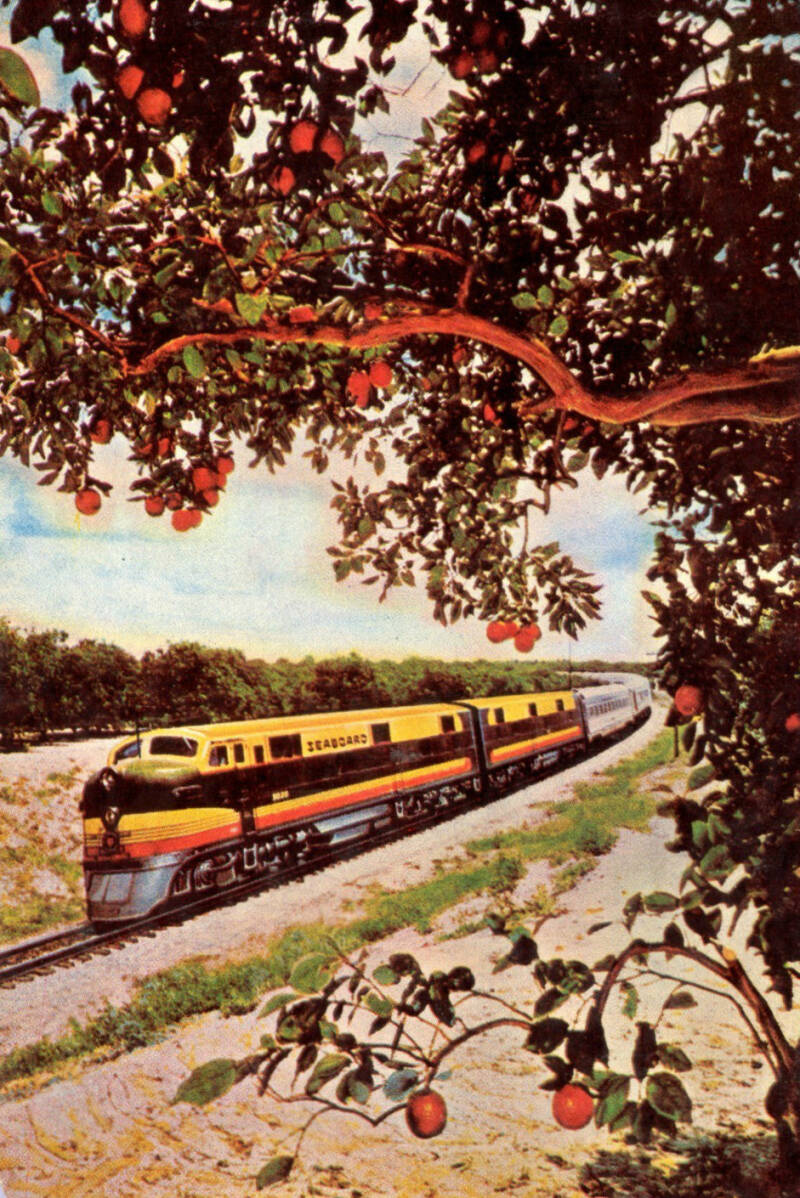RF&P No. 1013 with Train 57, The Silver Meteor, and to the left SCL No. 574 with The Gulf Coast Special at Broad Street Station on November 11, 1968.
(Photo by Roger Puta, courtesy Marty Bernard, railfan 44, Public domain, via Wikimedia Commons)

SILVER METEOR (SAL)
The Silver Meteor was inaugurated by the Seaboard Air Line Railroad (SAL) on February 2, 1939. The name was selected via contest, with 30 people among 76,000 entrants proposing the winning name. Utilizing EMC E4 diesel locomotives originally purchased for SAL's flagship all-Pullman train, the Orange Blossom Special, it became the first diesel-powered streamliner to Florida. Its introduction later prompted SAL's competitor, the Atlantic Coast Line Railroad (ACL), to introduce its own New York-Florida streamliner, the Champion, on December 1, 1939. The SAL emphasized the train's modernity, referring to it as the "Train of Tomorrow" and having its first trip to Florida begin not from New York Penn Station, but from the Long Island Rail Road station at the 1939 New York World's Fair. The original schedule took 25 hours.
Seaboard Air Line Railroad (SAL) glass-roofed "Sun Lounge" Hollywood Beach, a 5-double-bedroom-bar-lounge Pullman car introduced in 1956. Regular dome cars were too high for the tunnel clearances on the Northeast Corridor used by SAL trains north of Washington. (jpmueller99 from Shenandoah Valley of VA, USA, CC BY 2.0 <https://creativecommons.org/licenses/by/2.0>, via Wikimedia Commons)
Interior of the "Sun Lounge". (Dexter Press / State Archives of Florida, Florida Memory)
Equipment
The train used seven new cars manufactured by the Budd Company, those being a baggage-dormitory-coach, a diner straddled by two coaches on either side, and a coach-lounge-observation. The train was originally tri-weekly, alternating service between Miami and St. Petersburg every other day. However, the train proved to be so popular that after new equipment was delivered, SAL upgraded the train to daily operation to both coasts in December 1939. Heavyweight sleeping cars would be added to the train in 1941, and would be upgraded to lightweight sleeping cars in 1947. In 1956, SAL introduced the Sun Lounge to the train. These cars included five double-bedrooms on one end, and a lounge with glass panels in the roof. This was due to the fact that full dome cars could not fit through the tunnels on the Northeast Corridor between New York and Washington D.C.
The original Silver Meteor used lightweight cars built by the Budd Company. Three consists were needed for a daily train between New York and Miami; each had a baggage-dormitory-coach (22 seats), three 60-seat coaches, a tavern-lounge-coach (30 seats), a dining car, and a coach-observation-lounge (48 seats). Some of the coaches were owned by the Pennsylvania Railroad. Budd delivered more cars in November–December 1940, allowing daily service to St. Petersburg: three baggage-dormitory-coaches (18 seats), seven 56-seat coaches, two dining cars, and three coach-buffet-observation cars (30 seats).
By the early 1960s, the SAL's Silver Meteor typically had 17 cars or more, consisting of nine Pullman sleeping cars including its highly touted glass-topped Sun Lounge introduced in 1956, several coaches, two dining cars, and an observation car with tavern.
Postcard photo of the observation car of Seaboard's "Silver Meteor" train, which traveled from New York to Florida.
(Seaboard Railroad/Dexter Press, Pearl River New York published the card., Public domain, via Wikimedia Commons)
Operation
The Pennsylvania Railroad carried the train from New York to Washington along its mainline—now the Northeast Corridor—under a haulage agreement. Between Washington and Richmond, Virginia it used the Richmond, Fredericksburg and Potomac Railroad, jointly owned by the SAL and five other railroads. South of Richmond, the train used SAL's own mainline via Raleigh, North Carolina, Columbia, South Carolina, Savannah, Georgia, Jacksonville, Florida and Ocala, Florida. At Wildwood, Florida, the train was split into east and west coast sections. The east coast section continued to Miami, and the west coast section to Tampa, where the train would be split again into a St. Petersburg section and a Venice section via Sarasota. The Venice section was normally handled by SAL Motorcar 2028.
Postcard photo of the Seaboard streamliner the Silver Meteor.
(Ross photo service, New York., Public domain, via Wikimedia Commons)
Merger and Amtrak
The Seaboard Air Line Railroad merged with the Atlantic Coast Line Railroad to form the Seaboard Coast Line Railroad in 1967, and in 1968 the new railroad reshuffled the Florida streamliners. The Silver Meteor lost its west coast section and began serving Miami only. The Pennsylvania Railroad merged with the New York Central Railroad to form Penn Central Transportation in 1968, which inherited the longstanding haulage agreement for the Silver Meteor. Amtrak retained the train when it took over most intercity passenger trains on May 1, 1971.
A Silver Meteor Schedule from 1961.
(Self-scanned from the collection of JGHowes, Public domain, via Wikimedia Commons)
Overview
Service type: Inter-city rail
Locale: East Coast of the United States
First service: February 2, 1939
Current operator: Amtrak (1971–present)
Former operators: Seaboard Air Line Railroad (1939–1967), Seaboard Coast Line Railroad (1967–1971), Pennsylvania Railroad (1939–1968, haulage agreement), Penn Central Transportation (1968–1971, haulage agreement)
SAL's streamlined 4-6-2 Pacific locomotive No. 865 with the Silver Meteor's St. Petersburg section, in the 1940's.
(Photo by G.W. Pettengill Jr., reprinted in Passenger Train Journal, Vol. 21, No. 10 (October 1989)
Fair use, Title 17, Section 107, Portion used cropped and uploaded by User:JGHowes)







